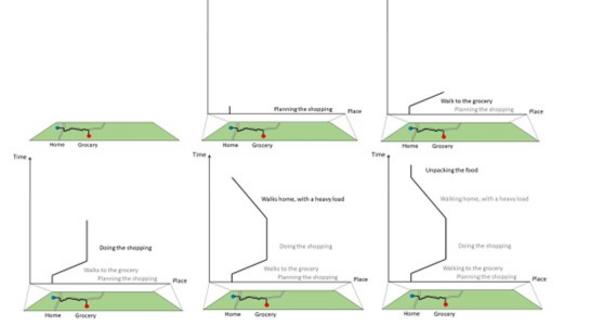
More about Time Geography
Time-geography is a mode of thinking, an approach, which helps in the understanding of change in society at individual, household and community levels as well as ecological consequences of human actions.
The time-geographic approach provides conceptual tools and a notation system useful for investigating processes of societal change. It helps in analyzing how one and the same need is satisfied differently depending on where, when and by whom the activities are performed. It has to do with variations in available resources, in terms of knowledge, technologies and tools, and the opportunities and constraints that influence people’s ability to arrange the resources so that they are within reach when needed to perform activities aimed at achieving goals and satisfying needs. The latter concerns couplings in time and space, which is a main issue for time-geography.
Successful performance of activities to achieve goals claims for couplings in time and space between the involved persons on one hand, and these persons and the tools and other resources needed on the other. Then, the time-space location of people and resources is essential. When considering couplings in time and space the individual’s dependence on other individuals is underlined, which helps reveal what might hinder, or facilitate, the achievement of individual and organizational goals. The two seemingly simple dimensions of time and space help sort out things that otherwise might be perceived as entangled and not subject to a coherent logic.
The founder of time-geography, Torsten Hägerstrand, professor in human geography, Lund University, Sweden, wrote that, “The approach is not in itself a theory. It is rather an ontological contribution preceding formation of theory.” When developing time-geography, he struggled with the problem of the very short step between “what is self-evident and extremely complicated” (1985: 195). The approach takes its points of departure in phenomena that at first glance seem self-evident, and utilizes these phenomena to construct concepts that assist interpretation of complicated and complex relations and appearances at the micro and macro level.
A citation from Hägerstrand may serve as an overall introduction to the time-geographic approach:
“Our actions leave traces in the physical world. We produce things and bring about states of a sort that nature does not shape on its own. Most traces have a short duration. Others lead to more lasting changes. In most cases there is a limited and comprehensible purpose behind the specific actions. In addition, most actions – probably all – have consequences which were not taken into account in the moment of action. It is quite easy to discover such unintended consequences in the immediate neighbourhood. Consequences with a wide reach and a slow course are more difficult to grasp.” (Hägerstrand 1995: 35)
Time-geography has a specific notation system which connect the two dimensions time and space (or place) and helps understanding that whatever happens has a geographic location. The core of the notation system is the concept “individual path” (or “trajectory” or “time-space path”). The ground for this is found in Hägerstrand’s first publication on time-geography, where he wrote that: “[T]ime does not admit escape for the individual. ( . . . ) As long as he is alive at all, he has to pass every point on the time-scale” (Hägerstrand 1970: 10).
Below is an illustration of the construction of an individual path of a human. The individual path can be used for other kinds of individuals like artificial things, objects in nature and animals, and at different scales, such as day, year, and life. The individual path shows when an individual has been located where in the time-space. The path does not reveal the feelings, emotions or experiences of a specific human individual. Such information can be illustrated in multiple contexts of daily activities (Ellegård 2019: 111).

The construction of an individual path: The map and the vertical time axis are core dimensions. The individual path is constructed along as the individual performs activities (which takes time) and as s/he moves geographically, the path changes direction in the place dimension while it goes on moving along the time axis. The individual path exemplified with Mr Svenson and his shopping ingredients for a party he will arrange in the evening (Ellegård 2019: 29).